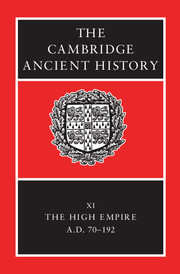Book contents
- Frontmatter
- PART I NARRATIVE
- PART II GOVERNMENT AND CIVIL ADMINISTRATION
- PART III THE EMPIRE
- PART IV ROME, ITALY AND THE PROVINCES
- 12 Rome and Italy
- 13 Spain
- 14 Gaul
- 15 Roman Germany
- 16 Africa
- 17 Cyrenaica
- 18 Britain
- 19 The Danube provinces
- 20 Greece and Asia Minor
- 21 Syria and Arabia
- 22 Judaea
- PART Va ECONOMY AND SOCIETY
- PART Vb ART AND CULTURE
- Chronological Table
- BIBLIOGRAPHY
- Index
- 1 The Roman world in the time of Marcus Aurelius
- 7 The Danube provinces
- References
13 - Spain
from PART IV - ROME, ITALY AND THE PROVINCES
Published online by Cambridge University Press: 28 March 2008
- Frontmatter
- PART I NARRATIVE
- PART II GOVERNMENT AND CIVIL ADMINISTRATION
- PART III THE EMPIRE
- PART IV ROME, ITALY AND THE PROVINCES
- 12 Rome and Italy
- 13 Spain
- 14 Gaul
- 15 Roman Germany
- 16 Africa
- 17 Cyrenaica
- 18 Britain
- 19 The Danube provinces
- 20 Greece and Asia Minor
- 21 Syria and Arabia
- 22 Judaea
- PART Va ECONOMY AND SOCIETY
- PART Vb ART AND CULTURE
- Chronological Table
- BIBLIOGRAPHY
- Index
- 1 The Roman world in the time of Marcus Aurelius
- 7 The Danube provinces
- References
Summary
The period of two generations following the civil wars of a.d 68–9 was in many respects the zenith in the history of Roman Spain. The proclamation as emperor of Galba, the governor of Hispania Citerior, demonstrated the political significance which Spain had already assumed by 68. The notion that Spain had become ‘Roman’ in almost the same sense as Italy was demonstrated by the grant of the Latin right to ‘all’ inhabitants of the Spanish provinces by Vespasian and, more particularly, by the foundation of several municipia by the Flavian emperors, first of all in the interior and then in the north-west of the Iberian peninsula, where romanization had, on the whole, made rather modest progress in the past, but also in the south, where several small towns received municipal status. The advent and the influence of senators from the Iberian peninsula in Rome, already apparent under the Flavian dynasty, emphasized the political power of Spanish élites, and with the accession of Trajan, born at Italica (Santiponce near Seville), a Spaniard achieved the position of emperor. He was succeeded by Hadrian, his compatriot, and, after the reign of Antoninus Pius, by Marcus Aurelius, whose ancestors also came from one of the towns of Baetica, Ucubi (Espejo). Economic prosperity and cultural growth, no less emphatically expressed by the splendour of most Spanish towns under the Flavians and in the early second century, complete the picture of this development. It may be symptomatic that the two perhaps most impressive monuments of Roman Spain were constructed during this period: the bridge over the Tagus (Tajo) at Alcantara, built under Trajan, and the aqueduct of Segovia, probably built under Domitian and inaugurated under Trajan.
- Type
- Chapter
- Information
- The Cambridge Ancient History , pp. 444 - 461Publisher: Cambridge University PressPrint publication year: 2000
References
- 4
- Cited by



